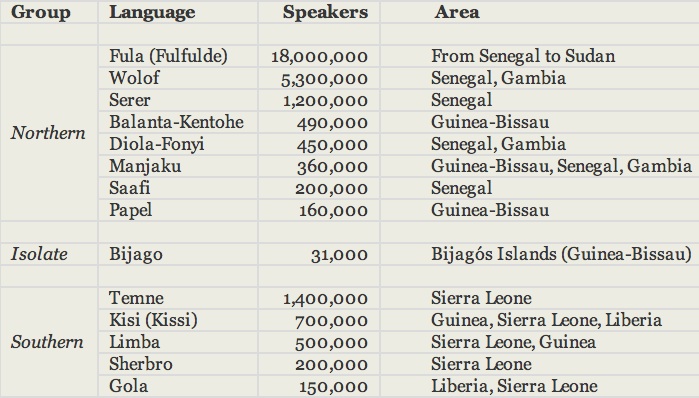An insatiable appetite for ancient and modern tongues


Overview. The Atlantic languages are the westernmost branch (or family) of Niger-Congo. They are spoken in the west coast of Africa, ranging from Senegal to Liberia and including, also, Gambia, Guinea-Bissau, Guinea, and Sierra Leone. Fula is the only Atlantic language to stretch inland, ranging from Senegal to Sudan. In contrast, Wolof, the second largest member of the family, is restricted to Senegal and Gambia.
External Classification: Niger-Congo, Atlantic-Congo, Atlantic.
Internal Classification and Speakers: There are approximately 45 Atlantic languages divided into Northern and Southern groups plus Bijago, circumscribed to the Bijagós Islands off the coast of Guinea-Bissau. Northern Atlantic languages are spoken mainly in Senegal, Gambia and Guinea-Bissau while Southern Atlantic languages are spoken in Guinea, Sierra Leone and Liberia. Around 30 million people speak an Atlantic language.

SHARED FEATURES
-
✦ Phonology
-
-Many Atlantic languages have implosives (though Wolof does not have them) and prenasalized consonants.
-
-Languages of the southern group have labio-velar consonants, that are comparatively rare among world languages.
-
-Languages of the northern group exhibit ATR vowel harmony. In it there is a contrast between vowels pronounced with an advanced tongue root (+ATR) and a retracted tongue root (-ATR): only vowels from (+ATR) set or from (-ATR) set appear in the same morpheme.
-
-Uniquely among Niger-Congo, most Atlantic languages lack tones.
-
✦ Morphology
-
-Prevalence of noun-class systems (similar to those of Bantu languages) marked by prefixes (e.g. Temne) or suffixes (e.g. Fula). In Wolof, nouns are not marked but the marker (a single consonant) is prefixed to nominal determiners. The number of noun-classes varies from 3 to 25. Some classes are reserved for singular nouns and others for plurals. Some classes include semantically related nouns, others are based on morphological categories, others are miscellaneous.
-
-Another distinctive feature of Atlantic languages is the system of agreement or concordance between noun modifiers and the noun i.e., they all share the same class prefix. This concord can extend also to the verb.
-
-Related to the noun-class system is the phenomenon of initial consonant mutation by which the initial consonants of nouns, adjectives and verb stems alternate between a basic stop grade in the singular and a fricative or nasal grade in the plural. The place of articulation stays the same but the manner of articulation of the consonant changes. For example: p → f ; d → nd, w → ng, etc.
-
-Many Atlantic languages have complex verbal systems in which a number of derivational and inflectional suffixes are added to the verbal root. The former, called also verbal extensions, encode causative, reciprocal, benefactive, passive and other meanings.
-
✦ Syntax
-
-In Atlantic languages word order is generally Subject-Verb-Object though an emphasized word may take the initial position in the sentence. They use prepositions and are head-initial: within the noun phrase, all modifiers follow the head noun.
-
© 2013 Alejandro Gutman and Beatriz Avanzati
Further Reading
-
-A Linguistic Geography of Africa. B. Heine & D. Nurse. Cambridge University Press (2008).
-
-An Introduction to African Languages. G. Tucker Childs. John Benjamins (2003).
-
-'Niger-Kordofanian (Niger-Congo) Languages'. D. Pulleyblank. In The World's Major Languages, 857-865. B. Comrie (ed). Routledge (2009).
Atlantic Languages

Address comments and questions to: gutman37@yahoo.com
MAIN LANGUAGE FAMILIES
LANGUAGE AREAS
Languages of Ethiopia & Eritrea
LANGUAGES by COUNTRY
LANGUAGE MAPS
-
• America
-
• Asia
-
Countries & Regions
-
-
Families
-
• Europe
-
• Oceania